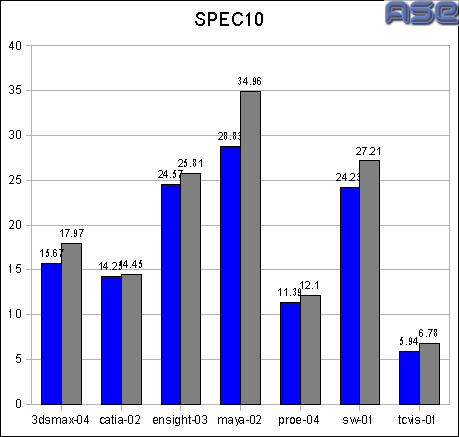Page 3: Installation, Testing, Conclusion
Installation:
Installing the card was no different than any other graphics card except that you need to install the RAM since once the card is installed, there is no turning back. The Asus P5N-T Deluxe shown works fine the Sapphire 3870 Ultimate with the northbridge heatsink and RAM. Granted, there isn't much clearance, but there is enough. The Asus P5E3 Deluxe also had no problems with the card and I suspect most motherboards should work fine. Be mindful that you should have proper ventilation in your case. Just because you want a silent system doesn't mean you should allow heat build up.
Testing:
All testing on ASE Labs is done with the current version of Ubuntu (8.04 at the time of this writing). The Ultimate was tested with the newest Catalyst 8.5 drivers that were just released from ATI's site. The Catalyst Control Center was also installed along side. Testing was initially done on an Asus P5N-T Deluxe but a problem with the board made that impossible. The new test setup consisted of an Asus P5E3 Deluxe with 2GB of Crucial PC3-1600 RAM and a Core 2 Quad Q6600 running at 2.7GHz (1800MHz FSB). The Ultimate was tested against the Toxic reviewed last month to compare a silent card with a comparatively noisy one.
A word on the P5N-T Deluxe problem. This board has a very weird problem with the Toxic edition of the Sapphire 3870 series. The board works fine the the Ultimate edition and a MSI 8600GTS but the board refuses to detect any hard drive while the Toxic is being used. These crazy hardware issues really plague current system builders with problems that just should be. Who's fault is this? Certainly it isn't Sapphire's since the card works as expected in other systems.
The AMD Catalyst Control Center still needs work to get up to its Windows counterpart but progress is being made. The information provided by the CCC shows the card is running at the rated specs. Compiz Fusion works well with the fglrx driver and while it is a non-free binary blob, the radeonhd driver is coming out sooner or later and will provide everything in a completely free driver. Even worse is that the fglrx driver still doesn't support Crossfire. I suspect that this year we will see more and more support for Linux coming out. Linux is truly the future.
I tested this card using the newly released SPECviewperf 10 benchmark. It is probably the best professional OpenGL benchmark and really tests a graphics card very well overall. As you can see, the Toxic bests the Ultimate due to it being the faster card.
I also tested the card in Nexuiz, which is a free and open source FPS. On the highest settings at 1920x1200, the card was 1 FPS behind the Toxic on average. At those settings, the Toxic managed to push 40 FPS average while the Ultimate was 39 FPS. You'll hardly notice the difference.
For a passively cooled card, you are getting great performance. Remember that the goal here is to provide good performance with no noise. You can't just look at raw performance alone.
Conclusion:
You know, I couldn't find the pricing for this card at any site. I guess the retail channel doesn't have this card just yet. You can bet that it will be competitively priced and the passive cooling of this card gives it the edge for a silent PC. You really can't put a price on how great it is to have a nice and silent PC and this card certainly helps meet that goal. Sapphire makes a great product once again and once the card hits retail, I'm sure it will be great. Silent PC builders will want to snap this card up when they can. I highly recommend it.
I'd like to thank Don from Sapphire for supplying this card for review.
Installing the card was no different than any other graphics card except that you need to install the RAM since once the card is installed, there is no turning back. The Asus P5N-T Deluxe shown works fine the Sapphire 3870 Ultimate with the northbridge heatsink and RAM. Granted, there isn't much clearance, but there is enough. The Asus P5E3 Deluxe also had no problems with the card and I suspect most motherboards should work fine. Be mindful that you should have proper ventilation in your case. Just because you want a silent system doesn't mean you should allow heat build up.
Testing:
All testing on ASE Labs is done with the current version of Ubuntu (8.04 at the time of this writing). The Ultimate was tested with the newest Catalyst 8.5 drivers that were just released from ATI's site. The Catalyst Control Center was also installed along side. Testing was initially done on an Asus P5N-T Deluxe but a problem with the board made that impossible. The new test setup consisted of an Asus P5E3 Deluxe with 2GB of Crucial PC3-1600 RAM and a Core 2 Quad Q6600 running at 2.7GHz (1800MHz FSB). The Ultimate was tested against the Toxic reviewed last month to compare a silent card with a comparatively noisy one.
A word on the P5N-T Deluxe problem. This board has a very weird problem with the Toxic edition of the Sapphire 3870 series. The board works fine the the Ultimate edition and a MSI 8600GTS but the board refuses to detect any hard drive while the Toxic is being used. These crazy hardware issues really plague current system builders with problems that just should be. Who's fault is this? Certainly it isn't Sapphire's since the card works as expected in other systems.
The AMD Catalyst Control Center still needs work to get up to its Windows counterpart but progress is being made. The information provided by the CCC shows the card is running at the rated specs. Compiz Fusion works well with the fglrx driver and while it is a non-free binary blob, the radeonhd driver is coming out sooner or later and will provide everything in a completely free driver. Even worse is that the fglrx driver still doesn't support Crossfire. I suspect that this year we will see more and more support for Linux coming out. Linux is truly the future.
I tested this card using the newly released SPECviewperf 10 benchmark. It is probably the best professional OpenGL benchmark and really tests a graphics card very well overall. As you can see, the Toxic bests the Ultimate due to it being the faster card.
I also tested the card in Nexuiz, which is a free and open source FPS. On the highest settings at 1920x1200, the card was 1 FPS behind the Toxic on average. At those settings, the Toxic managed to push 40 FPS average while the Ultimate was 39 FPS. You'll hardly notice the difference.
For a passively cooled card, you are getting great performance. Remember that the goal here is to provide good performance with no noise. You can't just look at raw performance alone.
Conclusion:
You know, I couldn't find the pricing for this card at any site. I guess the retail channel doesn't have this card just yet. You can bet that it will be competitively priced and the passive cooling of this card gives it the edge for a silent PC. You really can't put a price on how great it is to have a nice and silent PC and this card certainly helps meet that goal. Sapphire makes a great product once again and once the card hits retail, I'm sure it will be great. Silent PC builders will want to snap this card up when they can. I highly recommend it.
I'd like to thank Don from Sapphire for supplying this card for review.





